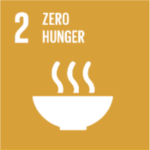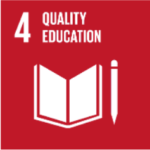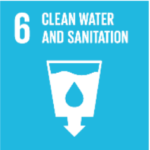SDG 2 - ZERO HUNGER
Apayao State College (ASC), as a Higher Education Institution in the country, is committed to contributing to the attainment of SDG 2: Zero Hunger. The P/A/Ps under this SDG include the following:
2024
This project aims to develop a model that enhances food security, builds the capacities of the food-poor families in pilot communities, and supports the development management of their resources. Five (5) recipient barangays in Conner -Apayao – Buluan, Karikitan, Paddaoan, Talifugo, and Ili – were organized into food associations, each comprising at least fifty (50) members with respective sets of officers. These food organizations were registered with the Department of Labor and Employment (DOLE).
The project consisted of four (4) major components:
- Vegetable garden in every home- initial seeds of assorted vegetables were provided to be planted in their own home gardens and a community security garden per barangay;
- Fruit tree in every home- grafted seedlings of Rambutan and Lanzones were given to be planted along with the vegetables;
- Organic fertilizer production in every home- 100 gram of African Night Crawlers (ANCs) were provided as starting stock for the development of Vermicast and Vermicompost which will serve as organic fertilizers for the vegetables; and
- Native chickens in every home- 1 pair of native chickens was given as a starting
- The project Complementary Food Production was initiated by the Department of Science and Technology with the following objectives:
- To introduce affordable and nutritious complementary foods (instant baby food and snack food) using rice blended with mongo and/or sesame by providing the appropriate technologies;
- To facilitate the technology adoption and commercialization of three (3) FNRI-developed complementary food technologies, namely rice-mongo curls, rice-mongo instant baby food blend, and rice-mongo-sesame baby food blend, especially in areas where technology is not widely available; and
- To strengthen the partnership between DOST, LGUs, the private sector, and other institutions in the implementing the project in five (5)
The Complementary Food Products are the following:
- Rice-mongo curls
- Rice-mongo instant baby food blend
- Rice-mongo sesame baby food blend
- Nutribun carrot variant
- Nutribun squash variant
2023
Generally, this project aims to capacitate farmers, barangay officials, and municipal officials on disaster risk reduction and climate change resiliency through science and technology interventions at the farm level and in communities in the province of Apayao to ensure food security amidst the COVID-19 pandemic. Specifically, it aimed to capacitate a pool of champions with site-specific S&T knowledge to address disaster risk reduction and climate change adaptation and mitigation; develop resilient farms against adverse impacts of climate change through the introduction of S&T interventions interventions/ technologies that will ensure sustainable food production; develop IEC materials on disaster preparedness and climate change mitigation and adaptation; enhance the role of women in disaster risk reduction and climate change adaptation and mitigation; and develop and recommend policies on disaster risk reduction and climate change adaptation and mitigation for barangays and municipalities. The total cost of the project is PhP2,375,000.00, funded by the PLGU of Apayao with 17 farmer cooperators from the five municipalities of Apayao (Flora, Sta Marela, Calanasan, Conner, and Kabugao).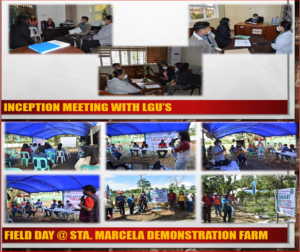



Distribution of Calamansi and Lemon seedlings to the Kabugao


Distribution of Calamansi, Lemon, and Vegetable seedlings and agricultural tools like sprinkle, bolo, and shovel to the Calanasan, Apayao Farmer cooperators.




Demonstration Farm at Barangay San Antonio, Sta. Marcela, Apayao Apayao
This project aims to develop a model to enhance food security, enhance the capacities of the food-poor families in the pilot communities, and develop and manage their resources. There were five (5) recipient barangays organized into food associations (Buluan, Karikitan, Paddaoan, Talifugo, and Ili) in Conner, Apayao with at least fifty (50) members and respective sets of officers. The different food organizations were registered with the Department of Labor and Employment (DOLE).
The four major component of the project were:
- Vegetable garden in every home- initial seeds of assorted vegetables were provided to be planted in their own home gardens and a community security garden per barangay;
- Fruit tree in every home- grafted seedlings of Rambutan and Lanzones were given to be planted along with the vegetables;
- Organic fertilizer production in every home- 100 gram of African Night Crawlers (ANCs) were provided as starting stock for the development of Vermicast and Vermicompost which will serve as organic fertilizers for the vegetables; and
- Native chickens in every home- 1 pair of native chickens was given as a starting
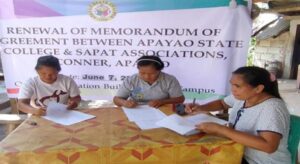
MOA Signing between ASC and SAPAT
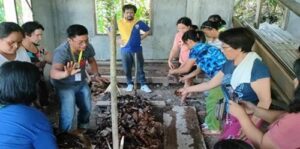
Training on Mushroom Production
Complementary Food Project (CFP)
- The project Complementary Food Production was initiated by the Department of Science and Technology with the following objectives:
- To introduce affordable and nutritious complementary foods (instant baby food and snack food) using rice blended with mongo and/or sesame by providing the appropriate technologies;
- To facilitate the technology adoption and commercialization of three (3) FNRI-developed complementary food technologies, namely rice-mongo curls, rice-mongo instant baby food blend, and rice-mongo-sesame baby food blend, especially in areas where technology is not widely available; and
- To strengthen the partnership between DOST, LGUs, the private sector, and other institutions in the implementation of the project in five (5) regions.
The Complementary Food Products are the following:
- Rice-mongo curls
- Rice-mongo instant baby food blend
- Rice-mongo sesame baby food blend
- Nutribun carrot variant
- Nutribun squash variant
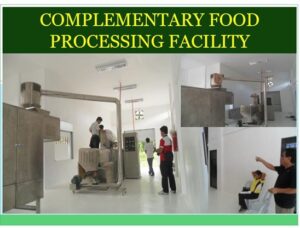



2022
Agriculture, Aquatic, and Natural Resources (AANR) Research Category
Agustina G. Pattung, Nathaniel T. Llamelo and Satur B. Bangyad
ABSTRACT
This study was part of the research component of the Conservation Agriculture in Forest Ecosystem (CAFÉ) Project of Apayao State College which aimed to establish appropriate cropping combinations in mid-elevation areas of Apayao and focused on poverty reduction, better food security, and stimulation of the rural economy and preserving the grandeur of Apayao’s remaining forest cover. Findings revealed that the growth and yield of mungbean were better when they receive longer duration of sunlight. Also, the better performance of pineapples in crop combination 4 may be attributed to the soil fertility in which the area was located at the lower portion of a slope while combination 8 was located at the ridge of a hill. Furthermore, the yield of ginger was better when integrated with banana which provided a cooler microclimate for the cash crops. For yam, the variety Ramayan and Padihot registered higher yield in the two cropping combinations while for Tannia, bigger planting materials should be used. The findings of this study might be used to encourage the integration of cash crops in a forest-based ecosystem as alternative income source for the households in the uplands.
Maricel Calasag and Mirasol L. Agpuldo
ABSTRACT
This study was conducted to determine the status and implementation of the High Yielding Technology Adoption (HYTA) Project of the Department of Agriculture-Regional Field Unit (DA-RFU), Cordillera Administrative Region (CAR). The extent of implementation of the project were in terms of the delivery of services, extension contact of Agricultural Extension Workers (AEWs) and the project beneficiaries. Results of the study showed that HYTA Fund increased in all participating farmers group that helped the farmer beneficiaries in augmenting the cost of production. The overall status of HYTA fund in the four municipalities has increased and 90 % of the respondents are benefited from the rollover fund that it helped them increased the production following the Rice Crop Manager recommendation. On financial capacities, it was seen that records management (ledger and subsidiaries), observance of transparencies, trained officers were lacking in the participating farmers groups. As to the extent of implementation on the different component of the project coupled with extension services rendered by the AEWs in each municipality, the beneficiaries were very satisfied.
Marfel Angelo V. Fontanilla & Tonette P. Laude
ABSTRACT
This study aims to determine the most applicable selection procedure in improving both the testcross and population per se performance of the two quality protein maize synthetics, SYQ5 and SYQ6, which were previously found to show good heterotic pattern, high general combining ability and high parental estimate. Selfed families and reciprocal testcrosses were generated and evaluated in Bukidnon and Apayao for grain yield and component traits, agronomic, and stress related traits. Grain yield had moderate to high correlations with yield component traits, while moderate to low correlations were observed across locations, and no significant resemblance between the selfed family and testcross. The selfed families and testcrosses showed high yielding variants and a moderate to moderately high heritability estimates ensuring high genetic gain from selection. In testcrosses, narrow-sense heritability estimates were low indicating higher dominance governing grain yield in the cross. Testcross selection, however, led to negative correlated response in selfed families, while testcrosses had positive but low correlated response from selfed family selection. The combined selection methods maintained high predicted response on both the testcrosses and selfed families. Simultaneous improvement of SYQ5 and SYQ6 brought additive reciprocal gain to their cross. The combined testcross and selfed family selection with estimation of genetic variance components is therefore the most applicable for this heterotic population.
Marfel Angelo Fontanilla, Rannie James Bayagan, Marites F. Garillo, Mirasol L. Agpuldo
ABSTRACT
The study aimed to determine the optimum seeding rate and NPK fertilization rate for mungbean production while considering the best return of investment. Two experiments consisting of four seeding rates, namely, 15kg/ha (SR15), 20kg/ha (SR20), 25kg/ha (SR25), and 30kg/ha (SR30), and four NPK fertilization rates, namely, 21kg/ha (FR21), 28kg/ha (FR28), 35kg/ha (FR35), and 42kg/ha (FR42), were implemented from March to June 2021. The seeding rate significantly differentiate the population density reflecting 264,000, 327,000, 427,000, and 509,000 plants/ha, respectively. NPK fertilization were reflected by significant differences in plant height attained. Pod length, number of seeds per pod, and 100-grain weight were not affected by the treatment levels indicating low environmental effects on these traits. Treatment differences was significantly reflected in total number of pods harvested and grain yield at first priming only. SR30 and FR42 recorded the highest total yield at 1,355kg/ha and 1,347kg/ha, respectively. ROI were highest in SR30 with 80.2% followed by FR42 with 71.9%. For a farmer with limited investment, it is recommended to plant only the area that can be covered by the investment to get the highest ROI instead of extending the area but limiting the inputs such as seeds and fertilizer.
Ronald O. Ocampo
ABSTRACT
A 2.5 Million pesos was granted to Apayao State College during the term of Dr. Nieves A. Dacyon as college president and was implemented during the term of Dr. Nelia Z. Cauilan by the Department of Agriculture- Bureau of Agricultural Research. The researcher faced several problems in the implementation such as the implementation of the TRAIN law in 2018 and the change in the college administration.
This study intends to disseminate indigenous fruit processing technologies developed by the researcher to households and farmers in the province of Apayao. This was piloted to the municipalities of Pudtol and Luna, Apayao. From the results of the study, following are concluded: Indigenous fruits in Apayao can be processed into wine, vinegar and fruit preserves that can be used in various culinary uses. Women do most of the activities in the fruit processing industry but men share a portion of their time especially in the sourcing out of raw materials. Wines and vinegar gave the highest return of investment ( ROI) among the products developed from indigenous fruits. In the light of the findings and conclusion, the following are forwarded as recommendations: Forward to the provincial and local government offices the findings of this study for possible collaboration for its dissemination. Collaborate with DTI and private entrepreneur for the establishment of business hub in Apayao to promote the developed products. Utilize the wines and vinegars in various culinary products to increase its marketability. Explore the processing potentials of other indigenous fruits in Apayao.
Leilani A. Parugrug, Quennie A. Berbano
ABSTRACT
This study was conducted to determine the acceptability of herbs added as infusions to enhance the appearance, taste and aroma of salted egg. This study used six (6) local herbs: lemon grass (Cymbopogon citratus); red hot chilies (Capsicum frutescens); garlic (Allium sativum); ginger (Zingiber officinale); pandan leaves (Pandanus odorasitimus), and turmeric (Curcuma longa). The mixtures of water, salt, and herbs were cooked for 15 minutes. Upon cooling, the duck eggs were soaked to the brine mixture. Containers were kept in a clean place for the 14-day curing period. Eggs were harvested and cooked for three (3) hours using medium heat. Products were subjected to sensory evaluation by 30 volunteer panelists. The study used ranking to determine the preference of consumers five (5) as the score for the “very much like,” to one (1) as score for the “least like.” Acceptability of the cut appearance of the herb infused eggs and its yolk showed that turmeric was “very much like”. Turmeric yielded bright yellow egg yolks while lemon grass formed paler egg yolks. Mean scores on the acceptability of the taste of the products showed that ginger and turmeric infused were “very much like”. Hot chillies, garlic and pandan were “least liked”. Aroma of the different treatments showed that ginger infused egg was “very much liked”. At PhP10.00 per piece, a producer still gets 40 to 45percent ROI. Salted eggs quality can be enhanced through the infusion of locally available herbs and spices. Ginger infused egg was preferred for taste. Ginger and turmeric infusions yielded the best in terms of appearance and aroma. Shelf-life analysis will be conducted as a follow up to this study.
Maria Christina Z. Manicad, Hannie T. Martin, David A. Rodolfo, Rodel A. Tapuro, Olivia C. Tomas Violeta D. Ducyao
ABSTRACT
The study was conducted to determine the performance of Lubeg seedlings applied with organic fertilizer and inorganic (14-14-14) fertilizer out-planted in the field. Specifically, it aims to assess the effect of varying levels of 14-14-14 with basal application of vermicompost on the field performance of Lubeg seedlings; and to find out the best effect of 14-14-14 and with basal application of vermicompost on the growth and survival of Lubeg seedlings out-planted in the field. The study was laid out in Randomized Complete Block Design with three (3) replications per treatment. The following treatments were used in the study, control (treatment 0), 10 g 14-14-14 (treatment 1), 20 g 14-14-14 (treatment 2), 40 g 14-14-14 (treatment 3). Result showed that no significant effects were observed among treatments in all the parameters assessed in the study except for the Lubeg seedlings survival. This revealed significant result at the end of the observation period (90 DAF) in which both untreated seedlings and seedlings applied with 20g 14-14-14 had the highest rate of seedlings survival (100%) followed by the seedlings applied with 10g 14-14-14 (93.3%) and the seedlings applied with 40g 14-14-14 had the lowest rate of seedlings survival.
Keywords: Field performance, Lubeg, organic, inorganic, RCBD
Menardo D. Villanueva, Ph.D., John Alvin A. Concepcion and Nathaniel T. Llamelo
ABSTRACT
The study was conducted to evaluate the influence of different concoctions to the growth performance of Dominant Cz F1 layer chicken as water supplement using Completely Randomized Design (CRD) at Apayao State College, Cubet, Malama, Conner, Apayao. Results of the study showed that the commercial probiotics and concoctions did not vary significantly on the growth performance as to the weekly body weight, gain weight, percentage rate growth, feed and water consumption. Although the result was not significant numerically, the body weight and gain weight of treated birds with concoctions were higher than the inclusion of commercial probiotics. However, the inclusion of commercial probiotics and concoctions shows significant differences on the fourth week of weekly body weight, gain weight and percentage rate growth. No significant variations were also noted in the feed conversion ratio and feed conversion efficiency. The study concluded that concoctions (IMO, FFJ and OHN) increases and improve the growth performance of Dominant Cz F1 layer chicken which comparable to Commercial Probiotics based on final body weight and final gain in weight. The inclusion of concoctions is recommended as it increases the growth performance of chicken.
Keywords: Concoctions, growth performance, dominant F1, CRD
Menardo D. Villanueva and Nathaniel T. Llamelo
ABSTRACT
The study was conducted to evaluate the effect of using different levels of malunggay leaf meal (MLM) supplemented to Dominant Cz F1 layer chicken diets. The experiment was laid out in Completely Randomized Design (CRD) with three replications. Based on the result of the study, the inclusion of MLM as feed supplement did not influence the laying performance of Dominant Cz F1 with the given parameters evaluated in the study. With egg production based on classification, birds with 6% MLM produced larger sized of eggs. From this result, MLM is a potential feed supplement for layers. For the result of the study, the inclusion of 6 % of MLM as feed supplement for layers is recommended because birds produced larger size of eggs which is economically important for a layer enterprise. Likewise, the Malunggay leaf meal should be included in formulating the ration so that the nutrient composition of the ration will be balance based on the nutrient requirement of layers.
Keywords: Laying performance, dominant F1, CRD
Industry, Energy, and Emerging Technology Research Category
Leandro B. Alla
ABSTRACT
Pancake is one of the most preferable snacks of many people because of its delicious taste and it is very ease to make. The study aimed to determine the acceptability of pancake with squash and taro as additive. This study used experimentation and survey among fifty (50) panel of evaluators to compare the different treatments used in terms of taste, aroma, appearance and texture using a 5-point Likert Scale. It also sought to determine the overall acceptability of Tarobasa Pancake using a 9-point Hedonic scale. Results showed that pancake enriched with ½ cup of mashed taro and squash was very flavorful, very aromatic and very fine while the addition of 1 cup mashed taro and squash was very appealing. As to overall acceptability, addition of ½ cup mashed taro and squash is the best concentration to be added in producing Tarobasa Pancake.
Mary Anne P. Umayam, Cristian Marlowe Barroga, Edison Perdido, Jayson Fuerte, and Angel Fuerte
ABSTRACT
This study was aimed to study the acceptability of calamansi flavored nipa wine. Specifically, it was intended to determine and compare the sample treatments in terms of taste, aroma, texture, appearance, and acceptability. The different treatments were T0- Nipa wine (control), T1- nipa wine + 1 cup of calamansi juice + 1 cup of light brown sugar, T2- nipa wine + ¼ cup of calamansi juice + ½ cup of light brown sugar. The samples were evaluated by 100 respondents in terms of taste, texture, aroma, appearance, and acceptability. Results revealed that both treatments are very much accepted by the respondents in terms of taste, texture, aroma, appearance, and acceptability. Hence, nipa wine can be further improved using calamansi juice and light brown sugar. Production of calamansi flavored nipa wine should be taken as part of income generating project of the college. Calamansi flavored nipa wine should be promoted so that it will be known in the locality and to target market. Enhance the packaging design for an added market value of the product. Conduct other researches with adding some ratios on the treatments that was used.
Mary Anne P. Umayam, Charry Mae Caligan, Mark Shaolin Sabado, and Kenneth Paul Menor
ABSTRACT
A polvoron is a type of andalusian shortbread of Levantine originated popularly in Spain and Latin America and other ex-spanish colonies such as the Philippines. The primary objective of the study is to test the acceptability of chili polvoron as well as to determine the best among the three treatments conducted. Results of the study showed that chili polvoron mixed with 5 grams chili powder was the best compared to the other treatments (10g and 15g chili powder mixed) in terms of taste, texture, aroma and appearance. Promotion should be done in order to create or increase demand of chili flavored polvoron. Mass production of chili flavored polvoron and market testing to the potential outlet should be done to determine the market share and demand of the product.
SOCIAL RESEARCH CATEGORY
Nathaniel T. Llamelo, Lorna Q. Caraang, Ronald O. Ocampo and Mirasol L. Agpuldo
ABSTRACT
This paper aims to characterize the Tarakitak production systems in Apayao in terms of demographic profile of growers, description of the production areas, its importance to the communities and the province, and the factors affecting Tarakitak production. Primary data were collected from the 40 Tarakitak growers in the Municipalities of Luna, Pudtol, Flora and Sta. Marcela, Apayao using survey questionnaires on Key Informant Interview and validated through Focus Group Discussion. Data were analyzed through the use of descriptive statistics of frequency count and percentage. Results of the study revealed Tarakitak production in the 4 study sites were generally small scale as relay crop or intercrop with upland rice. It plays an important role in the financial system of the farmers and promotion of social and cultural traditions of the province as one of the cultural symbols of Apayao. The main limitation of Tarakitak production was the high incidence of Banana Bunchy Top Virus (BBTV) and pests like corm weevils, cutworms, aphids, snails, monkeys, wild pigs and birds. Other factors that are considerably important are topography and access to agricultural information. Thus, there is a need to give emphasis on these factors in order to increase profitability of Tarakitak in the province.










